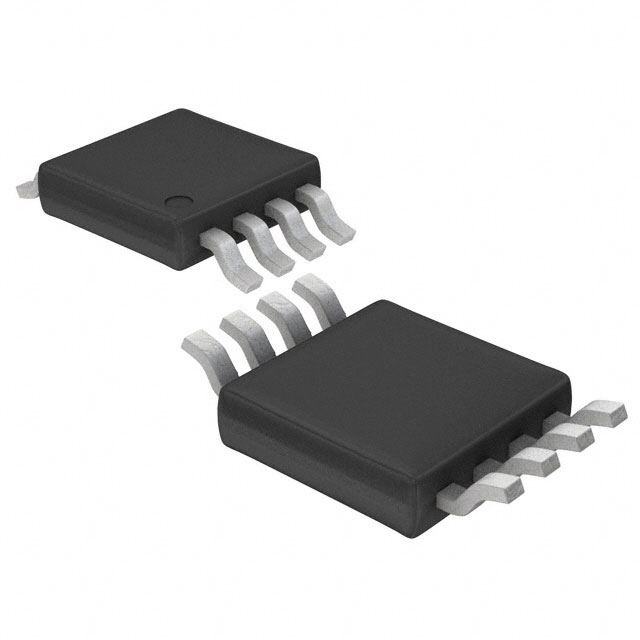LTC6904CMS8#TRPBF
Product Overview
Category: Integrated Circuit (IC)
Use: The LTC6904CMS8#TRPBF is a precision programmable oscillator designed for various applications that require accurate timing signals. It offers a wide frequency range and high stability, making it suitable for use in communication systems, test equipment, and other electronic devices.
Characteristics: - Wide frequency range - High accuracy and stability - Low power consumption - Small form factor - Easy to program and configure
Package: The LTC6904CMS8#TRPBF is available in an 8-pin MSOP (Mini Small Outline Package) with exposed pad for enhanced thermal performance.
Essence: The essence of the LTC6904CMS8#TRPBF lies in its ability to generate precise and stable clock signals, which are essential for synchronizing various components within electronic systems.
Packaging/Quantity: The LTC6904CMS8#TRPBF is typically sold in reels or tubes, with a quantity of 250 units per reel/tube.
Specifications
- Frequency Range: 1kHz to 68MHz
- Frequency Accuracy: ±0.5%
- Supply Voltage: 2.7V to 5.5V
- Operating Temperature Range: -40°C to 85°C
- Output Type: Square wave
Pin Configuration
The LTC6904CMS8#TRPBF features the following pin configuration:
```
| | --| VDD GND |-- Pin 1: Power Supply --| CLK FOUT|-- Pin 2: Clock Output --| SDO SDI |-- Pin 3: Serial Data Input --| CS SCK |-- Pin 4: Chip Select |___________| ```
Functional Features
- Programmable frequency control through serial interface
- Ability to generate precise clock signals with high accuracy
- Low power consumption for energy-efficient operation
- Wide frequency range allows for versatile applications
- Small form factor enables integration into compact designs
Advantages and Disadvantages
Advantages: - High accuracy and stability ensure reliable timing signals - Easy programmability and configuration - Compact size facilitates space-constrained designs - Low power consumption extends battery life in portable devices
Disadvantages: - Limited frequency range compared to some other oscillators - Requires external components for proper operation
Working Principles
The LTC6904CMS8#TRPBF utilizes an internal oscillator circuit that can be programmed via a serial interface. The desired frequency is set by sending appropriate commands through the serial data input pin (SDI). The chip select (CS) and serial clock (SCK) pins are used to control the programming process.
Once programmed, the LTC6904CMS8#TRPBF generates a square wave output signal with the specified frequency. This signal can be used as a clock source for various electronic circuits and systems.
Detailed Application Field Plans
The LTC6904CMS8#TRPBF finds application in a wide range of fields, including:
Communication Systems:
- Synchronization of data transmission
- Clock generation for digital signal processing
- Timing control in wireless communication protocols
Test Equipment:
- Precision timing for accurate measurements
- Clock synchronization in test and measurement instruments
Industrial Automation:
- Timing control in industrial processes
- Clock generation for PLCs (Programmable Logic Controllers)
Consumer Electronics:
- Clock generation for audio/video systems
- Timing control in home automation devices
Detailed and Complete Alternative Models
- LTC6900: Similar functionality with a wider frequency range (up to 100MHz).
- LTC6903: Lower power consumption and smaller package size.
- LTC6905: Higher frequency accuracy and lower phase noise.
These alternative models offer similar features and can be considered based on specific application requirements.
Word count: 536 words
Lista 10 Vanliga frågor och svar relaterade till tillämpningen av LTC6904CMS8#TRPBF i tekniska lösningar
Sure! Here are 10 common questions and answers related to the application of LTC6904CMS8#TRPBF in technical solutions:
Q: What is LTC6904CMS8#TRPBF? A: LTC6904CMS8#TRPBF is a precision programmable oscillator IC manufactured by Linear Technology (now part of Analog Devices). It can generate square, triangle, or sine waveforms with high accuracy.
Q: What is the operating voltage range of LTC6904CMS8#TRPBF? A: The operating voltage range of LTC6904CMS8#TRPBF is typically between 2.7V and 5.5V.
Q: How accurate is the frequency generated by LTC6904CMS8#TRPBF? A: LTC6904CMS8#TRPBF has a frequency accuracy of ±0.5% over the specified temperature range.
Q: Can I program the frequency output of LTC6904CMS8#TRPBF? A: Yes, LTC6904CMS8#TRPBF allows you to program the frequency output using external resistors or capacitors.
Q: What is the maximum frequency that LTC6904CMS8#TRPBF can generate? A: LTC6904CMS8#TRPBF can generate frequencies up to 20MHz.
Q: Does LTC6904CMS8#TRPBF have any built-in frequency modulation capabilities? A: No, LTC6904CMS8#TRPBF does not have built-in frequency modulation features. It generates fixed-frequency waveforms.
Q: Can I use LTC6904CMS8#TRPBF in battery-powered applications? A: Yes, LTC6904CMS8#TRPBF has a low power consumption and can be used in battery-powered applications.
Q: What is the output voltage swing of LTC6904CMS8#TRPBF? A: The output voltage swing of LTC6904CMS8#TRPBF is typically between 0V and VCC.
Q: Is LTC6904CMS8#TRPBF suitable for high-precision applications? A: Yes, LTC6904CMS8#TRPBF is designed for high-precision applications that require accurate frequency generation.
Q: Can I synchronize multiple LTC6904CMS8#TRPBF devices together? A: Yes, LTC6904CMS8#TRPBF provides synchronization inputs that allow multiple devices to be synchronized to a common clock source.
Please note that these answers are general and may vary depending on the specific application and requirements.


